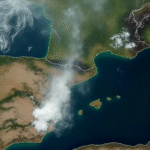Background on Sargasso Seaweed and Its Impact
Sargasso seaweed, a floating marine macroalgae, has been causing significant impacts on coastal areas in Quintana Roo, Mexico. This phenomenon affects tourism, coastal ecosystems, and local communities.
Key Players Involved
- Red de Monitoreo de Sargazo de Quintana Roo: A monitoring network dedicated to tracking sargasso seaweed in Quintana Roo.
- Laboratorio de Oceanografía Óptica de la Universidad del Sur de Florida: A research laboratory providing oceanographic data, including sargasso seaweed information.
- Tourism and Society Think Tank: A platform that collects and disseminates reports on tourism-related issues, including sargasso seaweed.
Anticipated Increase in Sargasso Seaweed Recurrences
According to the report gathered by Tourism and Society Think Tank, an anticipated 40% increase in sargasso seaweed recurrences is expected in the Caribbean Mexican region compared to the 25% collected during the 2024 season.
This prediction aligns with data from the Laboratorio de Oceanografía Óptica de la Universidad del Sur de Florida, which reported a 150% increase in total sargasso seaweed in the Caribbean Sea, Gulf of Mexico, and western Atlantic Ocean in April compared to historical averages for that month.
Causes of Sargasso Seaweed Recurrences
The report attributes the increased sargasso seaweed recurrences to several factors:
- Rising sea temperatures
- Nutrient contributions from agricultural runoff in South America and Africa
- Changes in ocean currents that transport large sargasso seaweed masses to the Caribbean and Gulf of Mexico
Current Situation in Quintana Roo
As of May 23, the Red de Monitoreo de Sargazo de Quintana Roo has identified 40 million metric tons of sargasso seaweed floating in the ocean, with at least 10% (4 million tons) approaching Mexican Caribbean waters.
Approximately 90% of these 4 million tons are being carried by Yucatan Channel currents, leaving only 10% with a possibility of threatening Quintana Roo’s coasts, according to Esteban Amaro, director of the Red de Monitoreo de Sargazo (RMS).
This figure has forced the modification of previous seasonal sargasso seaweed projections, which initially suggested that the 2025 season could surpass the 25,000 tons collected in Quintana Roo’s coasts during 2024 by up to 40%.
Current Impact on Quintana Roo’s Beaches
By May 21, the Red de Monitoreo report documented excessive sargasso seaweed presence on 16 Quintana Roo beaches and abundant presence on another 31.
The remaining 53 beaches out of the 100 monitored in Quintana Roo report moderate to low recurrence levels.
Playa del Carmen has already collected 6,000 tons of sargasso seaweed this season, surpassing the previous year’s records. Although Puerto Morelos faces a similar situation, the interviewee highlighted the effectiveness of the sargasso seaweed containment efforts through the installation of offshore barriers.






